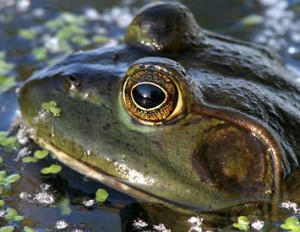Nature Notes by Dr. Frank Lang
Nature Notes is a long time member of the Crater Lake Natural History Association Board of Directors. The non-profit Association provides funding to the park and Oregon Caves for interpretive programs through our sale of books and other items. A board benefit is an occasional outing provided by the park. In August, the board was privileged to spend the night on Crater Lake’s Wizard Island courtesy of the Park Service. While there, three big fat toads along the trail surprised Nature Notes as he stumbled down from Wizard Island’s crater in the deepening twilight.
Although it might be his imagination, Nature Notes thinks the western toad, Bufo boreas, was once more common. He remembers finding toads the size of dinner plates in and
among the sword ferns and goat’s beard in the garden of his childhood home. Well, maybe saucers. Great warty beasts that Papa always encouraged because of the damage they inflicted on his garden archenemy, the common slug. Those toads, however, did nothing to help in his constant battle with his other garden enemy, the neighbor’s cat.
Now the cane or marine toad is another story. This six inch long toad, native to the Rio Grand south, was introduced to Florida after several tries where they have become, well, pests, famous for their gustatorial habitat of cleaning up Fido’s and Kitty’s uneaten pet food. Cane toads are voracious omnivores. Although they aren’t big enough to eat a cat, they have the where-with-all to kill one. Like many amphibians, their skins are toxic, toxic enough to kill a curious dog or cat. The toxin is produced by their parotid glands, the large warts back of both eyes. After handling a cane toad, be sure to wash your hands. Fortunately for the State of Jefferson, cane toads are sensitive to cold, which makes their presence on Wizard Island unlikely, the specter of global warming not withstanding.
But back to Bufo boreas. Toads on Wizard Island were unexpected. How did they get there? What do they eat? Insects and other Arthropods? Slugs? Many questions. They probably over winter by crawling down in the spaces between the large clunky chunks of lava rock that makes going anywhere on Wizard Island, except on trails, difficult.
Nature Notes knows from childhood experience that handling toads can be a hazard, for the handler and the toad. Handler gets peed upon when an overexcited toad looses a precious supply of fluid laced with toxins manufactured by glands in their bladder similar to those in its paratoid glands. In a relatively dry environment, toad has a rehydration problem. The handler just gets wet, unless he licks his fingers.
Contrary to popular belief, handling toads will not give you warts, peed upon or not. Warts are cause by viruses not present in toads. While Googling around for this piece, Nature Notes was surprised to learn that a duct tape bandage on a wart causes it to disappear. Better than silk threads and stump water, he bets. And finally, Nature Notes wonders what might happen if a truly desperate princess kissed a Wizard Island toad.
— Dr. Frank Lang
Other pages in this section
- Dr Frank Lang obituary, May 14, 1937 – June 26, 2019
- Alkali Flies
- Bald Eagles
- Bull Trout
- Christmas Trees
- Cryptosporidiosis
- Cucurbits
- Dicamptodon
- Dippers
- Earthworms
- Fens
- Fishing
- Grapeferns
- Helliborine Orchid
- Habitat
- Hairy Woodpecker
- Hibernation
- Klamath Midge
- Marshes
- More Yellowjackets
- Morels
- Mosquito Fern
- Mountain Beaver
- Myriapods
- Painted Ladies
- Pandora Moths
- Pikas
- Pronghorns
- Raccoons
- Robins
- Shaggy Manes
- Silver-Gray Squirrels
- Slugs
- Soils
- Songbirds
- Spotted Owl
- Spotted Skunk
- Subalpine Fir
- Ticks and Mites
- Water
- Watermelon Snow
- Water Bears
- Wocas
- Woodrats
- Yellowjackets
- Dr Frank Lang obituary, May 14, 1937 – June 26, 2019
- Alkali Flies
- Bald Eagles
- Bull Trout
- Christmas Trees
- Cryptosporidiosis
- Cucurbits
- Dicamptodon
- Dippers
- Earthworms
- Fens
- Fishing
- Grapeferns
- Helliborine Orchid
- Habitat
- Hairy Woodpecker
- Hibernation
- Klamath Midge
- Marshes
- More Yellowjackets
- Morels
- Mosquito Fern
- Mountain Beaver
- Myriapods
- Painted Ladies
- Pandora Moths
- Pikas
- Pronghorns
- Raccoons
- Robins
- Shaggy Manes
- Silver-Gray Squirrels
- Slugs
- Soils
- Songbirds
- Spotted Owl
- Spotted Skunk
- Subalpine Fir
- Ticks and Mites
- Water
- Watermelon Snow
- Water Bears
- Wocas
- Woodrats
- Yellowjackets


